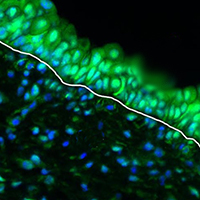Immunohistochemistry as a paramount tool in research of normal urothelium, bladder cancer and bladder pain syndrome

Submitted: 11 March 2021
Accepted: 19 March 2021
Published: 24 March 2021
Accepted: 19 March 2021
Abstract Views: 1288
PDF: 890
HTML: 9
HTML: 9
Publisher's note
All claims expressed in this article are solely those of the authors and do not necessarily represent those of their affiliated organizations, or those of the publisher, the editors and the reviewers. Any product that may be evaluated in this article or claim that may be made by its manufacturer is not guaranteed or endorsed by the publisher.
All claims expressed in this article are solely those of the authors and do not necessarily represent those of their affiliated organizations, or those of the publisher, the editors and the reviewers. Any product that may be evaluated in this article or claim that may be made by its manufacturer is not guaranteed or endorsed by the publisher.
Similar Articles
- H. Valpotić, A. Kovšca Janjatović, G. Lacković, F. Božić, V. Dobranić, D. Svoboda, I. Valpotić, M. Popović, Increased number of intestinal villous M cells in levamisole - pretreated weaned pigs experimentally infected with F4ac+ enterotoxigenic Escherichia coli strain , European Journal of Histochemistry: Vol. 54 No. 2 (2010)
- Meiying Zhang, Min Zhou, Xia Cai, Yan Zhou, Xueling Jiang, Yan Luo, Yue Hu, Rong Qiu, Yanrong Wu, Yuejin Zhang, Yan Xiong, VEGF promotes diabetic retinopathy by upregulating the PKC/ET/NF-κB/ICAM-1 signaling pathway , European Journal of Histochemistry: Vol. 66 No. 4 (2022)
- C Lucini, L Maruccio, R Antonucci, L Castaldo, Immunoreactivity to glial cell line-derived neurotrophic factor and its receptors in the trout pancreas: a further endocrine-exocrine relationship? , European Journal of Histochemistry: Vol. 52 No. 1 (2008)
- J. Pelz, W. Härtig, C. Weise, C. Hobohm, D. Schneider, M. Krueger, J. Kacza, D. Michalski, Endothelial barrier antigen-immunoreactivity is conversely associated with blood-brain barrier dysfunction after embolic stroke in rats , European Journal of Histochemistry: Vol. 57 No. 4 (2013)
- S. Iachettini, R. Valaperta, A. Marchesi, A. Perfetti, G. Cuomo, B. Fossati, L. Vaienti, E. Costa, G. Meola, R. Cardani, Tibialis anterior muscle needle biopsy and sensitive biomolecular methods: a useful tool in myotonic dystrophy type 1 , European Journal of Histochemistry: Vol. 59 No. 4 (2015)
- A. Mangas, J. Yajeya, N. González, S. Duleu, M. Geffard, R. Coveñas, NO-tryptophan: a new small molecule located in the rat brain , European Journal of Histochemistry: Vol. 60 No. 3 (2016)
- Carlo Alberto Redi, RNA therapeutics - Function, design and delivery , European Journal of Histochemistry: Vol. 55 No. 2 (2011)
- E Bronzetti, M Artico, I Kovacs, LM Felici, Expression of neurotransmitters and neurotrophins in neurogenic inflammation of the rat retina , European Journal of Histochemistry: Vol. 51 No. 4 (2007)
- S. Nemolato, J. Ekstrom, T. Cabras, C. Gerosa, D. Fanni, E. Di Felice, A. Locci, I. Messana, M. Castagnola, G. Faa, Immunoreactivity for thymosin beta 4 and thymosin beta 10 in the adult rat oro-gastro-intestinal tract , European Journal of Histochemistry: Vol. 57 No. 2 (2013)
- A Gigante, C Bevilacqua, A Pagnotta, S Manzotti, A Toesca, F Greco, Expression of NGF, Trka and p75 in human cartilage , European Journal of Histochemistry: Vol. 47 No. 4 (2003)
<< < 42 43 44 45 46 47 48 49 50 51 > >>
You may also start an advanced similarity search for this article.

 https://doi.org/10.4081/ejh.2021.3242
https://doi.org/10.4081/ejh.2021.3242










